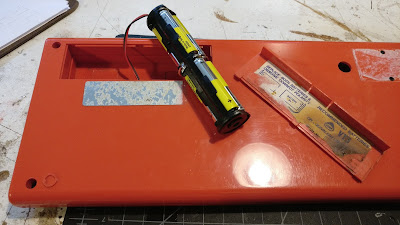Hello!?...
I have been clearing out my workshop and getting rid of things I don't want or
have time for, in the hopes of someday getting back to circuit bending and
blogging again, but just for my own amusement.
I am making a lot of progress, and my workshop is looking great, but I have
run into some things that are too precious to throw out but not worthy of
selling in the condition they are in. I had been holding onto this Waddingtons
Compute-A-Tune for at least a decade, and I couldn't bring myself to throw it
out. It had some major issues and was not worth even trying to sell for $20...
The Compute-A-Tune is a very old toy keyboard that i think was only sold in
the UK in the early 80's. The synthesizer is based around the TMS1000, which
if I am not mistaken-was the first microcontroller!
Unfortunately the original knobs that controlled the volume and "effect" had
broken off, and the circuit-board inside was heavily corroded since there
didn't appear to have ever been a solder mask.
So rather than just throwing the whole thing away, I decided to give it a face
lift. I started by reverse engineering the circuit, and found an additional
tempo, and another chord mode. Now to come up with a some modern upgrades. I
started with the power supply. The TMS1000 needs at least 15 volts to even
turn on. The keyboard ran off two 9 volt batteries in series. This seemed
wasteful to me so I built a circuit that would provide the TMS1000 17 volts
from one 9 volt input using an ICL7660S charge pump chip. These chips can be
noisy and don't deliver much current, but in this case there were no issues,
since the keyboard is already pretty alias-y, and very digital sounding. The
next step was to try and find a way to get the playback button to repeat after
the recorded melody had played through. For this, I used a CD4098 dual
monostabe multivibrator chip. I have been using these a lot lately. They are a
very useful chip for lots of reasons, but in this case i used the chip as a
re-settable pulse delay. Essentially, the gate output from the recorded melody
re-triggers a a delayed pulse, and as soon as there is no gate to reset the
delay, the pulse is able to re-trigger the "PLAY" switch, causing the recorded
melody to play continuously.
The next thing to do was create a more interesting mix of the square wave tone
and its three available sub octaves. I had seen a schematic floating around
for a diode VCA used in Lunetta circuits, but I had never actually tried it
before. I was pleasantly surprised with how well it worked, so I built one for
the top octave and another for the three subs. I used a CD4093 quad Nand gate
as inverting buffers for the VCA's, and for the sub octaves, I added a PWM
filter and a mixing switch to set different combinations of the sub octaves
Nand-ed together. With the remaining two Nand gates, I made two separate
trapezoid LFO's; one to modulate the PWM, and another for vibrato.
Next, I needed envelope generators for the VCA's, so I crafted two looping
attack-decay envelope generators from a CD4013 dual flip flop chip. I haven't
seen a circuit like it, so if you're inclined, take a look at my schematic. It
is simple but useful.
Once my circuits were all tested and working, I went to work redesigning the
keyboard and the interface. I cut out circuit boards on my desktop CNC, which
is always fun... The most challenging part being the circuit board with the
thumb-wheel pots, because the circuit board had to line up perfectly with the
existing mounting hole, and the pots had to stick out of the shell just right.
Somehow it came out perfect on the first try. Completely measuring the shell and
creating a 3D model of it helped.
Assembling everything was slow and tedious. I really didn't want to screw it
up, and there wasn't a lot of room to make mistakes. I was able to find a
battery compartment that holds 6 AAA batteries from a strange flashlight repair
parts site. It seemed like a strange site, but the battery compartment was
only $4, so I gave it a shot and it arrived in a couple of days. The battery
compartment needed to be modified slightly, but it fits perfectly inside the
original cavity.
There were a few mistakes along the way, but for the most part, everything
came out as planned. One thing that I only noticed once the mods were done, was
that the "TUNES" function is pretty much useless... I had thought that you
could use the four settings as places to store separate recorded melodies, but
I was wrong, and they only work to set the demo melody when the power is
reset. Had I known this, I wouldn't have included the setting in the mod. Oh
well.
I took lots of pictures along the way. click on any of them to see larger
views.




























So nice to see you’re posting again. I always loved reading your build write ups and dreaming of getting one of your devices (maybe one day). Until then I’ll settle for these!
ReplyDeleteThank you!! I am glad to see people still read these. More soon...
DeleteI just picked o e of these things up for pennies. I love the “sequencer” things -but even more like the idea of looping the pattern!
ReplyDeleteI must look athe Casio VLtone to see if this is also possible!